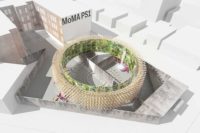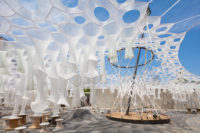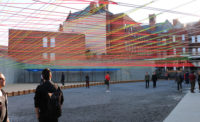| Photo courtesy MoMA PS1 |
The MoMA PS1 Young Architects Program was launched in 2000. Click on the slide show button to view past installations (pictured: Dunescape, SHoP Architects, 2000). |
MoMA PS1 takes a gamble when it selects finalists for its Young Architects Program, which each year gives emerging designers the chance to design an installation for a 10,000-square-foot triangular courtyard at the Queens art center.
The entrants don’t initially propose schemes; rather, they are selected to compete in the competition’s final stage based on the ingenuity of their past work. “There’s enormous suspense because we really don’t know what these people will do,” says Barry Bergdoll, the Philip Johnson Chief Curator of Architecture and Design at MoMA.
In November, MoMA PS1 announced the short list for the 2011 program. Three of the five firms hail from Brooklyn (FormlessFinder, Interboro Partners, and Matter Architecture Practice). One is based in Boston (MASS Design Group), while the third is from London (IJP Corporation Architects).
The teams will submit their designs on February 11. Shortly after, a jury will assess the concepts and announce a winner. The finalists were chosen from a pool of roughly 30 submissions by architecture school deans and editors at design publications.
The brief has remained relatively the same since the program was launched in 2000. For $80,000, designers must conceive an installation that provides shelter, seats, and water to the sweaty crowds that show up every summer weekend for the museum’s dance party “Warm Up.” In recent years, designers have scored extra points for sustainable aspects that aren’t too obvious.
“Every year we’re looking for a surprise, for something that’s new and unusual and fresh,” says Bergdoll. “Every year we think, how many ways are there to make an inexpensive, quickly erected solution for that courtyard?”
Bergdoll notes that entries often reflect the trends and technological advancements of the moment. For instance, when the program began, architects were excited about computer-numerical-controlled (CNC) cutting and it dominated the proposals. In 2008, WORK Architecture Company’s winning scheme “Public Farm One (P.F.1)” impressed the jury with its low-tech design, which “was a refreshing change,” he says, “that really hit the spirit of the moment beautifully.”
Last year’s winner, SO-IL’s “Pole Dance”—with its swaying poles covered with netting and various interactive aspects, including a complementary iPhone app—was equally responsive to its time. “We’re so interested now in thinking about an interconnected world,” Bergdoll says. “There are moments when [the winning designs] hit the commentary of the time in an insightful way.”






























Post a comment to this article
Report Abusive Comment